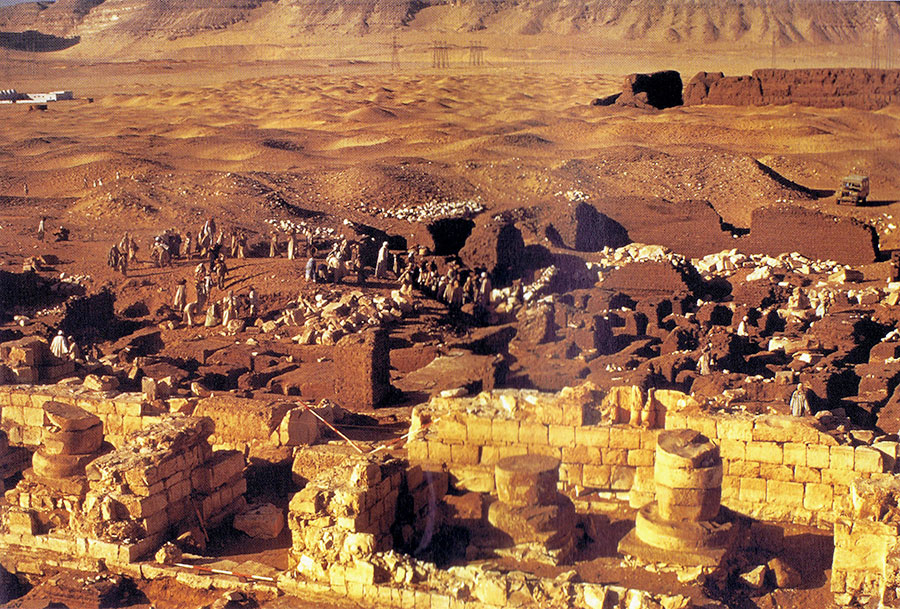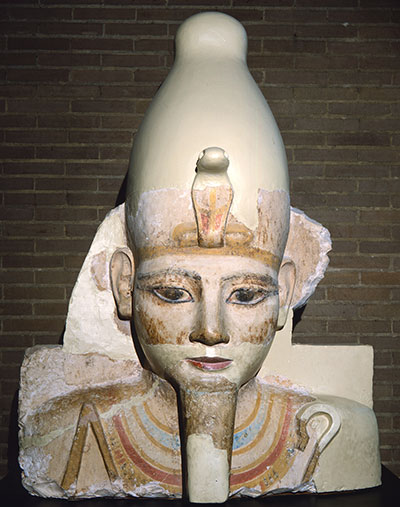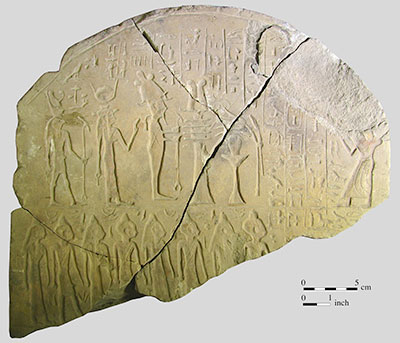
In 1967 a new team of excavators arrived at Abydos, a site of great extent located on the western side of the Nile Valley in southern Egypt. The co-directors of the team were myself, on behalf of the Penn Museum, and William Kelly Simpson of Yale University. We had been preceded by many other teams stretching back to the 1860s. Yet Abydos then—and for that matter, now—still had many archaeological mysteries to explore. The earlier excavators had defined the overall picture of Abydos’ archaeology, ranging from temples and royal tombs or cenotaphs (empty tombs) through vast cemeteries and ancient town sites to multitudes of burials of mummified sacred birds and animals. The primary focus for much of this activity had been the great funerary god Osiris, whom the Egyptians believed to have been buried at Abydos, although other gods and goddesses were also venerated there.
In spite of these early discoveries, the severe denudation of many of the monumental structures, large and small, and the sheer number of as yet unexcavated archaeological remains, left many important issues about Abydos unresolved. As a result Abydos particularly impressed me during an initial survey of possible sites throughout Egypt that we considered for our excavations. Abydos had been a place of great importance to the Egyptians and deserved to be better understood. It was also possible to do every kind of archaeology at the site.
In initiating new excavations at Abydos, Kelly and I, who had received a permit to excavate in North Abydos from the Antiquities Organization (now called the Ministry of Antiquities), hoped that over time we could foster the work of younger Egyptologists in other parts of Abydos, a prospect that fortunately was realized; projects now cover most of Abydos.

Our first seasons of excavation (1967, 1968, and 1969) were particularly hectic ones as the team sought to keep pace with a wealth of discoveries, while local builders were constructing an on-site residence, laboratory, and storerooms that the Egyptian authorities had given us permission to build. It also happened that these first seasons produced our most “museum worthy” finds. In modern archaeology, all archaeological data, from art works to broken pottery, are of equal value for scholarly research and require the same high levels of documentation. And we had not gone into the field with the specific aim of locating objects that might eventually, if the Egyptian authorities so wished, become included in the collections of our two sponsoring institutions, the Penn Museum and the Peabody Museum at Yale University.
However, it so happened that the Egyptian Antiquities Organization (which reported to the Ministry of Culture) had revived the old system of “partage” or division. This long-standing practice went back to the 19th century and ensured that, under the supervision of the Antiquities Organization, art works and artifacts discovered by an expedition could be shared between the Museum of Egyptian Antiquities in Cairo and the foreign institutions sponsoring the project. Renewing the division policy was part of a larger initiative—to grant permits to an increased number of reputable archaeological projects to excavate in Egypt in response to foreign participation in a massive campaign of salvage archaeology in Egyptian Nubia. The salvage operations took place in an area that became the reservoir created by a new dam at Aswan, in southern Egypt.
It so happened that our work over 1967–1969 generated art works and artifacts of particular interest, and in any case a partage was required as one of the conditions of our permit. Focused as I was on fieldwork intended to recover information about the past, I was somewhat bemused to be instructed by the Egyptian authorities in 1969 that we had to crate up our many significant items and get them to the Cairo Museum, where a committee of Egyptian scholars would decide what was to be kept by the Cairo Museum, and what could be assigned to the project’s sponsoring museums. I believe this was the last time that a partage on such a large scale was carried out in Egypt; later the division policy became more restrictive and eventually was brought to an end. This was a relief for archaeologists working in Egypt; thanks to the generosity of the Egyptian government we were—and still are—privileged to carry out research in Egypt, and we are not interested in the acquisition of objects for museums.
This particular division, however, provided impressive additions to the Egyptian collection of the Penn Museum, objects which had significance for many di6erent levels of Egyptian culture, and for understanding some of the unique activities that took place at Abydos in ancient times. Two examples of these items provide some impression of what I mean.
The most visually striking object consisted of the shoulders and most of the face of a colossal limestone statue of the famous pharaoh Ramses II. Much of the color had survived, providing a good idea of the attractively colorful impression such large-scale statuary could give. The statue fragments were discovered in the ruins of a temple Ramses II had had built overlooking the Osiris Temple at Abydos. The famous archaeologist Flinders Petrie had partially explored the ruins, and thought they represented a unique portal structure giving access to the vast cemetery to the west, but our excavations revealed it was more of a traditional temple type, with a pylon, forecourt, and roofed temple.


The head and shoulders survived the removal of most of the temple (for the purpose of reusing the building blocks) in antiquity. I still vividly remember the eerie impression its boldly defined eyes imparted as the head lay on its side in the dusty grime of the ruins. Restored, the head and shoulders now have a powerful presence in the Penn Museum’s 3rd floor Egyptian Gallery. The modeling is not very subtle, but that is because this is architectural statuary; originally, the colossal statue itself, when intact, was engaged with the masonry temple walls, like other statues of similar size that were ranged around a courtyard within the temple.
This impressive object added further strength to the Museum’s Egyptian collection. In overall substance and quality, this collection can be ranked as one of the major ones in the United States, and it is particularly strong in Ramesside period (19th and 20th Dynasties) art. These include the massive sphinx of Ramses II, rededicated to his successor king Merenptah; much architecture from the latter’s palace; and a finely modeled statue of king Ramses III.
The second object I discuss here is much more modest, yet shows how even minor works of art can be of considerable significance. We discovered that below the temple of Ramses II lay a dense mass of mud brick chapels, some comparatively large and many quite small (we explored these further in 1977). The associated pottery showed they dated to the Middle Kingdom; niches in their mud brick walls indicated that many of them had once contained inscribed stelae, but almost all of these had been removed, some probably anciently, others during poorly documented clearances in the 19th century.
However, we surmised these chapels were examples of structures frequently mentioned in Middle Kingdom texts from Abydos that had overlooked the processional way between the Osiris Temple and his supposed tomb at a remote desert location. Every year, a great festival procession of Osiris traversed this route, and the chapels housed images of Egyptians who thus hoped to “witness” this important religious event, literally forever.
However, we had no direct proof for our supposition until we discovered a small “window” stela, its upper half missing, lying in situ in front of a small chapel, in the doorway of which the stela had originally been set. This archaeologically and historically important item was also assigned to the Penn Museum. Only about 23 cm high (approximately 9 inches), this “window” would have framed a small statue within the chapel; via this image the man represented—named Ukh-hotep—expected to always view Osiris’ procession, according to the text on the stela itself. Many other artifacts—over 1,000 altogether—came into the Museum’s Egyptian collection as part of the last partage. Together they provide a rich illustration of the Egyptians’ enduring devotion to the cult of Osiris at Abydos.
